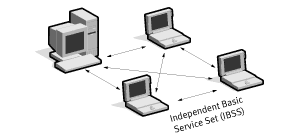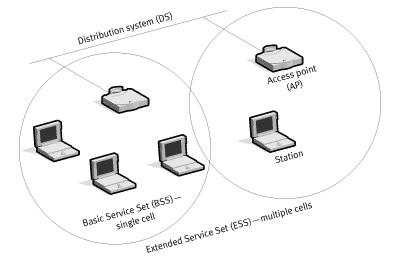
| Page 3 |

Regardless of the type of PHY chosen, IEEE 802.11 supports three basic topologies for WLANs—the Independent Basic Service Set (IBSS), the Basic Service Set (BSS), and the Extended Service Set (ESS).

IBSS configurations are also referred to as an independent configuration or an ad-hoc network. Logically, an IBSS configuration is analogous to a peer-to-peer office network in which no single node is required to function as a server. IBSS WLANs include a number of nodes or wireless stations that communicate directly with one another on an ad-hoc, peer-to-peer basis. Thus it contains set of wireless stations that communicate directly with one another without using an access point or any connection to a wired network. It is useful for quickly and easily setting up a wireless network at anyplace where a wireless infrastructure does not exist or is not required for services, such as a hotel room, convention center, or airport, or where access to the wired network is barred (such as for consultants at a client site). Generally, IBSS implementations cover a limited area and aren’t connected to any larger network
BSS consists of at least one access point connected to the wired network infrastructure and a set of wireless end stations. This configuration is called a Basic Service Set (BSS). Thus, BSS configurations rely on an Access Point (AP) that acts as the logical server for a single WLAN cell or channel. Communications between node A and node B actually flow from node A to the AP and then from the AP to node B.

An Extended Service Set (ESS) consists of a series of overlapping BSSs (each containing AP) connected together by means of a Distributed System (DS). Although the DS could be any type of network, it is almost invariably an Ethernet LAN. Mobile nodes can roam between APs and like this seamless campus-wide coverage is possible. Since most corporate WLANs require access to the wired LAN for services (file servers, printers, Internet links) they will operate in BSS/ESS topology.
Note that WLAN can be used either to replace wired LANs, or as an extension of the wired LAN infrastructure. 802.11 defines two pieces of equipment, a wireless station, which is normally a PC equipped with a wireless network interface card (NIC), and an access point (AP). AP acts as a bridge between the wireless and wired networks. It usually consists of a radio, a wired network interface (e.g., 802.3), and bridging software conforming to the 802.1d bridging standard. The access point acts as the base station for the wireless network, aggregating access for multiple wireless stations onto the wired network. Wireless end stations can be 802.11 PC Card, PCI, or ISA NICs, or embedded solutions in non-PC clients (such as an 802.11-based telephone handset).